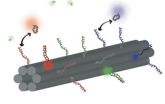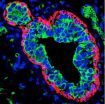(Press-News.org) Small proteins in the cornea protect against bacterial infection
Exposed tissue surfaces, including skin and mucous membranes, are under constant threat of attack by microorganisms in the environment. The layer of cells that line these areas, known as epithelial cells, are the first line of defense against these pathogens, but the underlying molecular mechanisms that allow them to repel microbes are unknown. In this issue of the Journal of Clinical Investigation, researchers at the University of California, Berkeley, report that epithelial cells in the cornea, which is highly resistant to bacterial infection, express small antimicrobial peptides, portions of human cytokeratin 6A, that defend the eye against infection. Using mass spectrometry, Suzanne Fleiszig and colleagues determined that these peptides protect against multiple bacterial pathogens by preventing the bacteria from binding to the epithelial cells. Additionally, they found that mice lacking cytokeratin 6A were more susceptible to eye infections. In an accompanying commentary, Michael Zasloff of Georgetown University School of Medicine discusses the implications of these findings for the development of antimicorbial therapeutics.
TITLE:
Cytokeratins mediate epithelial innate defense through their antimicrobial properties
AUTHOR CONTACT:
Suzanne Fleiszig
University of California at Berkeley, Berkeley, CA, USA
Phone: 510 643-0990; Fax: 510 643-5109; E-mail: fleiszig@berkeley.edu
View this article at: http://www.jci.org/articles/view/64416?key=ede08273cbaa5718b658
ACCOMPANYING COMMENTARY
TITLE:
Defending the cornea with antibacterial fragments of keratin
AUTHOR CONTACT:
Michael A. Zasloff
Georgetown University Medical Center, Washington, DC, USA
Phone: 202-687-8962; Fax: 202-687-2792; E-mail: maz5@georgetown.edu
View this article at: http://www.jci.org/articles/view/65380?key=44a31f9a7987a1f6fd5e
New insight into hyperporlactinemia-associated infertility
Hyperprolactinemia, the presence of abnormally high levels of the hormone prolactin, is a well-established cause of infertility in women in their 20s and 30s. This hormone imbalance is frequently associated with low levels of gonadotrophic-releasing hormone (GnRH), a lack of ovulation, and a decrease in menstruation; however, the molecular mechanisms by which excess prolactin causes infertility are unclear. In this issue of the Journal of Clinical Investigation, researchers led by Nadine Binart at the University of Paris report that high levels of prolactin block expression of kisspeptin, a protein hormone that induces secretion of GnRH. By administering kisspeptin, Binart and colleagues restored ovulation in mice with high levels of prolactin. In an accompanying article, Ursula Kaiser of Brigham and Women's Hospital in Boston discusses the implications of this research for the clinical treatment of infertility in patients with hyperprolactinemia.
TITLE:
Hyperprolactinemia-induced ovarian acyclicity is reversed by kisspeptin administration
AUTHOR CONTACT:
Nadine Binart
Inserm U 693, Le Kremlin Bicetre, UNK, FRA
Phone: 331-49596701; Fax: 331-49596732; E-mail: nadine.binart@inserm.fr
View this article at: http://www.jci.org/articles/view/63937?key=280ce0bc284f919d41a1
ACCOMPANYING THE ATTENDING PHYSICIAN
TITLE:
Hyperprolactinemia and infertility: new insights
AUTHOR CONTACT:
Ursula Kaiser
Brigham and Women's Hospital, Boston, MA, USA
Phone: 617-732-5768; Fax: 617-582-6193; E-mail: ukaiser@partners.org
View this article at: http://www.jci.org/articles/view/64455?key=bfeda7b4e5e1fa11a4b3
GATA transcription factors regulate pancreas development
Type 1 diabetes is caused by the autoimmune destruction of insulin-producing pancreatic β islets. Efforts to reverse the disease are focused on replacing these cells and current research is focused on identifying the factors that contribute to islet generation during embryonic development. In this issue of the Journal of Clinical Investigation two research teams led by Anabel Rojas at the Andalusian Center for Molecular Biology and Regenerative Medicine in Seville, Spain and Lori Sussel at Columbia University report that GATA4 and GATA6 transcription factors are required for development of the pancreas in mice. Mice deficient in both genes failed to develop a pancreas, exhibited hyperglycemia, and died shortly after birth, while mice deficient in only one of the genes had very minor defects. Mutations in GATA6 and GATA4 are frequently found in neonatal diabetic patients. In a companion commentary, Jorge Ferrer and colleagues at the Hospital Clinic of Barcelona, Spain discusses the transcriptional mechanisms that underlie pancreas formation and their relation to new regenerative therapies for type 1 diabetes.
TITLE:
GATA4 and GATA6 control mouse pancreas organogenesis
AUTHOR CONTACT:
Anabel Rojas
CABIMER, Sevilla, , ESP
Phone: +34 956467427; Fax: +34 954 461 464; E-mail: anabel.rojas@cabimer.es
View this article at: http://www.jci.org/articles/view/63240?key=c8a6bd31c727e2d3b763
ACCOMPANYING ARTICLE
TITLE:
Pancreas-specific deletion of mouse Gata4 and Gata6 causes pancreatic agenesis
AUTHOR CONTACT:
Lori Sussel
Columbia University, New York, NY, USA
Phone: 212-851-5115; E-mail: lgs2@columbia.edu
View this article at: http://www.jci.org/articles/view/63352?key=fb768d6ab25676b91c54
ACCOMPANYING COMMENTARY
TITLE:
GATA believe it: new essential regulators of pancreas development
AUTHOR CONTACT:
Jorge Ferrer
Hospital Clinic de Barcelona, Barcelona, , ESP
Phone: Tel +34 932275400 (office ext 3; Fax: +34 93 4516638; E-mail: jferrer@clinic.ub.es
View this article at: http://www.jci.org/articles/view/65751?key=af40e461737fe0703fce
MicroRNA links oncogenic signaling pathways in glioblastoma
Glioblastomas, the most prevalent primary brain tumor, frequently exhibit alterations in a number of signaling pathways that promote growth and metastasis; however, targeting of single elements has been clinically disappointing as the cancer cells simply reduce their reliance on targeted pathway. In this issue of the Journal of Clinical Investigation researchers at the Zhongshan School of Medicine in Ghuangzhou, China report on a microRNA, miR-182, that links two oncogenic signaling pathways in glioblastoma. MicroRNAs are molecules that suppress the expression of target genes. Jun Li and colleagues found that miR-182 was over-expressed in human glioblastoma patients and was correlated with the hyperactivation of two different oncogenic signaling pathways. Expression of miR-182 repressed expression of multiple negative regulators of these pathways, leading to sustained activation and enhanced malignancy. In a companion commentary, Christine Eyler of Brigham and Women's Hospital in Boston and Jeremy Rich of the Cleveland Clinic discuss the necessity of identifying multiple molecular targets within a given cancer to develop effective therapies.
TITLE:
TGF-β induces miR-182 to sustain NF-κB activation in glioma subsets
AUTHOR CONTACT:
Jun Li
Zhongshan School of Medicine, Sun Yat-sen University, Guangzhou, , CHN
Phone: +86(20)87335828; E-mail: lijun37@mail.sysu.edu.cn
View this article at: http://www.jci.org/articles/view/62339?key=f349f446cf2044913393
ACCOMPANYING COMMENTARY
TITLE:
Looking in the miR-ror: TGF-β–mediated activation of NF-κB in glioma
AUTHOR CONTACT:
Jeremy Rich
College of Medicine at Case Western Reserve University, Cleveland, OH, USA
Phone: 216.636.0790; Fax: 216.636.5454; E-mail: richj@ccf.org
View this article at: http://www.jci.org/articles/view/66058?key=e2a0f7a4caee9492bf27
### END
JCI early table of contents for September 24, 2012
2012-09-24
ELSE PRESS RELEASES FROM THIS DATE:
Small proteins in the cornea protect against bacterial infection
2012-09-24
Exposed tissue surfaces, including skin and mucous membranes, are under constant threat of attack by microorganisms in the environment. The layer of cells that line these areas, known as epithelial cells, are the first line of defense against these pathogens, but the underlying molecular mechanisms that allow them to repel microbes are unknown. In this issue of the Journal of Clinical Investigation, researchers at the University of California, Berkeley, report that epithelial cells in the cornea, which is highly resistant to bacterial infection, express small antimicrobial ...
Human brains outpace chimp brains in the womb
2012-09-24
VIDEO:
This movie shows a pregnant chimpanzee undergoing an ultrasound imaging procedure to explore brain growth in her fetus.
Click here for more information.
Humans' superior brain size in comparison to their chimpanzee cousins traces all the way back to the womb. That's according to a study reported in the September 25 issue of Current Biology, a Cell Press publication, that is the first to track and compare brain growth in chimpanzee and human fetuses.
"Nobody knew ...
Pregnancy complications up to twice higher in women born preterm
2012-09-24
This press release is available in French. Women who were born premature are more likely to have pregnancy complications than women who weren't, according to data analyzed by a team lead by Dr. Anne Monique Nuyt, a neonatal specialist and researcher at the Sainte-Justine Mother and Child University Hospital Center and University of Montreal. This is the first study to clearly show the impact of preterm birth (i.e. before 37 weeks of gestation) itself on pregnancy risks. "We knew that to be born with a low birth weight could be associated with increased risk of pregnancy ...
Research shows ants share decision-making, lessen vulnerability to 'information overload'
2012-09-24
TEMPE, Ariz. – Scientists at Arizona State University have discovered that ants utilize a strategy to handle "information overload." Temnothorax rugatulus ants, commonly found living in rock crevices in the Southwest, place the burden of making complicated decisions on the backs of the entire colony, rather than on an individual ant.
In a study published in the early, online version of scientific journal Current Biology, Stephen Pratt, an associate professor in ASU's School of Life Sciences in the College of Liberal Arts and Sciences, and Takao Sasaki, a graduate student ...
Researchers at Harvard's Wyss Institute engineer novel DNA barcode
2012-09-24
VIDEO:
DNA origami is a process that can be used to self-assemble shapes that are of nanometer dimensions -- 100 nanometers is about 1,000 times shorter than the width of an...
Click here for more information.
BOSTON, September 24, 2012—Much like the checkout clerk uses a machine that scans the barcodes on packages to identify what customers bought at the store, scientists use powerful microscopes and their own kinds of barcodes to help them identify various parts of a cell, ...
Study uncovers mechanism by which tumor suppressor MIG6 triggers cell suicide
2012-09-24
New York, NY and Uppsala, Sweden, September 24, 2012 – Death plays a big role in keeping things alive. Consider the tightly orchestrated suicide of cells--a phenomenon essential to everything from shaping an embryo to keeping it free of cancer later in life. When cells refuse to die, and instead multiply uncontrollably, they become what we call tumors. An intricate circuitry of biochemical reactions inside cells coordinates their self-sacrifice. Tracing that circuitry is, naturally, an important part of cancer research.
In a major contribution to that effort Dr. Ingvar ...
New study shows PTSD symptoms reduced in combat-exposed military via integrative medicine
2012-09-24
SAN DIEGO (Sept. 24, 2012) – Healing touch combined with guided imagery (HT+GI) provides significant clinical reductions in post-traumatic stress disorder (PTSD) symptoms for combat-exposed active duty military, according to a study released in the September issue of Military Medicine.
The report finds that patients receiving these complementary medicine interventions showed significant improvement in quality of life, as well as reduced depression and cynicism, compared to soldiers receiving treatment as usual alone.
The study, led by the Scripps Center for Integrative ...
Pacific Islanders have high obesity, smoking rates
2012-09-24
ANN ARBOR, Mich.—In the first study to detail the health of Pacific Islanders living in the United States, University of Michigan researchers have found alarmingly high rates of obesity and smoking.
The preliminary findings are being presented today (Sept. 24) at a conference in Los Angeles on health disparities among Native Hawaiians and Pacific Islanders.
"Native Hawaiians and Pacific Islanders are the second fastest growing minority population in the U.S.," said Sela Panapasa, a researcher at the U-M Institute for Social Research and principal investigator of the ...
Vitamin D deficiency increases risk of heart disease
2012-09-24
New research from the University of Copenhagen and Copenhagen University Hospital shows that low levels of vitamin D are associated with a markedly higher risk of heart attack and early death. The study involved more than 10,000 Danes and has been published in the well-reputed American journal Arteriosclerosis, Thrombosis and Vascular Biology.
Vitamin D deficiency has traditionally been linked with poor bone health. However, the results from several population studies indicate that a low level of this important vitamin may also be linked to a higher risk of ischemic heart ...
Climate is changing the Great Barrier Reef
2012-09-24
Satellite measurement of sea surface temperatures has yielded clear evidence of major changes taking place in the waters of Australia's Great Barrier Reef over the past 25 years, marine scientists have found.
The changes have big implications for the future management of the GBR and its marine protected areas say Dr Natalie Ban and Professor Bob Pressey of the ARC Centre of Excellence for Coral Reef Studies and James Cook University, who led the study with Dr Scarla Weeks from the University of Queensland.
"When we looked back at satellite data collected since 1985, ...


